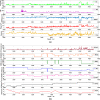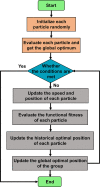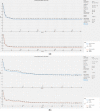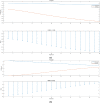An Advanced Long Short-Term Memory (LSTM) Neural Network Method for Predicting Rate of Penetration (ROP)
- PMID: 36643527
- PMCID: PMC9835522
- DOI: 10.1021/acsomega.2c06308
An Advanced Long Short-Term Memory (LSTM) Neural Network Method for Predicting Rate of Penetration (ROP)
Abstract
Rate of penetration (ROP) is an essential factor in drilling optimization and reducing the drilling cycle. Most of the traditional ROP prediction methods are based on building physical model and single intelligent algorithms, and the efficiency and accuracy of these prediction methods are very low. With the development of artificial intelligence, high-performance algorithms make reliable prediction possible from the data perspective. To improve ROP prediction efficiency and accuracy, this paper presents a method based on particle swarm algorithm for optimization of long short-term memory (LSTM) neural networks. In this paper, we consider the Tuha Shengbei block oilfield as an example. First, the Pearson correlation coefficient is used to measure the correlation between the characteristics and eight parameters are screened out, namely, the depth of the well, gamma, formation density, pore pressure, well diameter, drilling time, displacement, and drilling fluid density. Second, the PSO algorithm is employed to optimize the super-parameters in the construction of the LSTM model to the predict ROP. Third, we assessed model performance using the determination coefficient (R 2), root mean square error (RMSE), and mean absolute percentage error (MAPE). The evaluation results show that the optimized LSTM model achieves an R 2 of 0.978 and RMSE and MAPE are 0.287 and 12.862, respectively, hence overperforming the existing methods. The average accuracy of the optimized LSTM model is also improved by 44.2%, indicating that the prediction accuracy of the optimized model is higher. This proposed method can help to drill engineers and decision makers to better plan the drilling operation scheme and reduce the drilling cycle.
© 2022 The Authors. Published by American Chemical Society.
Conflict of interest statement
The authors declare no competing financial interest.
Figures













Similar articles
-
Real-time prediction of ROP based on GRU-Informer.Sci Rep. 2024 Jan 25;14(1):2133. doi: 10.1038/s41598-024-52261-7. Sci Rep. 2024. PMID: 38272964 Free PMC article.
-
ROP Prediction Method Based on PCA-Informer Modeling.ACS Omega. 2024 May 22;9(22):23822-23831. doi: 10.1021/acsomega.3c10339. eCollection 2024 Jun 4. ACS Omega. 2024. PMID: 38854564 Free PMC article.
-
Drilling Rate of Penetration Prediction Based on CBT-LSTM Neural Network.Sensors (Basel). 2024 Oct 30;24(21):6966. doi: 10.3390/s24216966. Sensors (Basel). 2024. PMID: 39517863 Free PMC article.
-
A cosine adaptive particle swarm optimization based long-short term memory method for urban green area prediction.PeerJ Comput Sci. 2024 May 28;10:e2048. doi: 10.7717/peerj-cs.2048. eCollection 2024. PeerJ Comput Sci. 2024. PMID: 38855216 Free PMC article.
-
The Application Potential of Artificial Intelligence and Numerical Simulation in the Research and Formulation Design of Drilling Fluid Gel Performance.Gels. 2024 Jun 17;10(6):403. doi: 10.3390/gels10060403. Gels. 2024. PMID: 38920949 Free PMC article. Review.
Cited by
-
Predicting the Rate of Penetration while Horizontal Drilling through Unconventional Reservoirs Using Artificial Intelligence.ACS Omega. 2024 Dec 4;9(50):49719-49727. doi: 10.1021/acsomega.4c08006. eCollection 2024 Dec 17. ACS Omega. 2024. PMID: 39713651 Free PMC article.
-
Real-time prediction of ROP based on GRU-Informer.Sci Rep. 2024 Jan 25;14(1):2133. doi: 10.1038/s41598-024-52261-7. Sci Rep. 2024. PMID: 38272964 Free PMC article.
-
ROP Prediction Method Based on PCA-Informer Modeling.ACS Omega. 2024 May 22;9(22):23822-23831. doi: 10.1021/acsomega.3c10339. eCollection 2024 Jun 4. ACS Omega. 2024. PMID: 38854564 Free PMC article.
References
-
- Hegde C.; Daigle H.; Gray K. E. Performance comparison of algorithms for real-time rate-of-penetration optimization in drilling using data-driven models. Spe J. 2018, 23, 1706–1722. 10.2118/191141-PA. - DOI
-
- Oyedere M.; Gray K. ROP and TOB optimization using machine learning classification algorithms. J. Nat. Gas Sci. Eng. 2020, 77, 10323010.1016/j.jngse.2020.103230. - DOI
-
- Ashrafi S. B.; Anemangely M.; Sabah M.; Ameri M. J. Application of hybrid artificial neural networks for predicting rate of penetration (ROP): A case study from Marun oil field. J. Pet. Sci. Eng. 2019, 175, 604–623. 10.1016/j.petrol.2018.12.013. - DOI
-
- Brenjkar E.; Delijani E. B. Computational prediction of the drilling rate of penetration (ROP): A comparison of various machine learning approaches and traditional models. J. Pet. Sci. Eng. 2022, 210, 11003310.1016/j.petrol.2021.110033. - DOI
-
- Mazen A. Z.; Rahmanian N.; Mujtaba I.; Hassanpour A. Prediction of Penetration Rate for PDC Bits Using Indices of Rock Drillability, Cuttings Removal, and Bit Wear. SPE Drill. Completion 2021, 36, 320–337. 10.2118/204231-PA. - DOI
LinkOut - more resources
Full Text Sources

